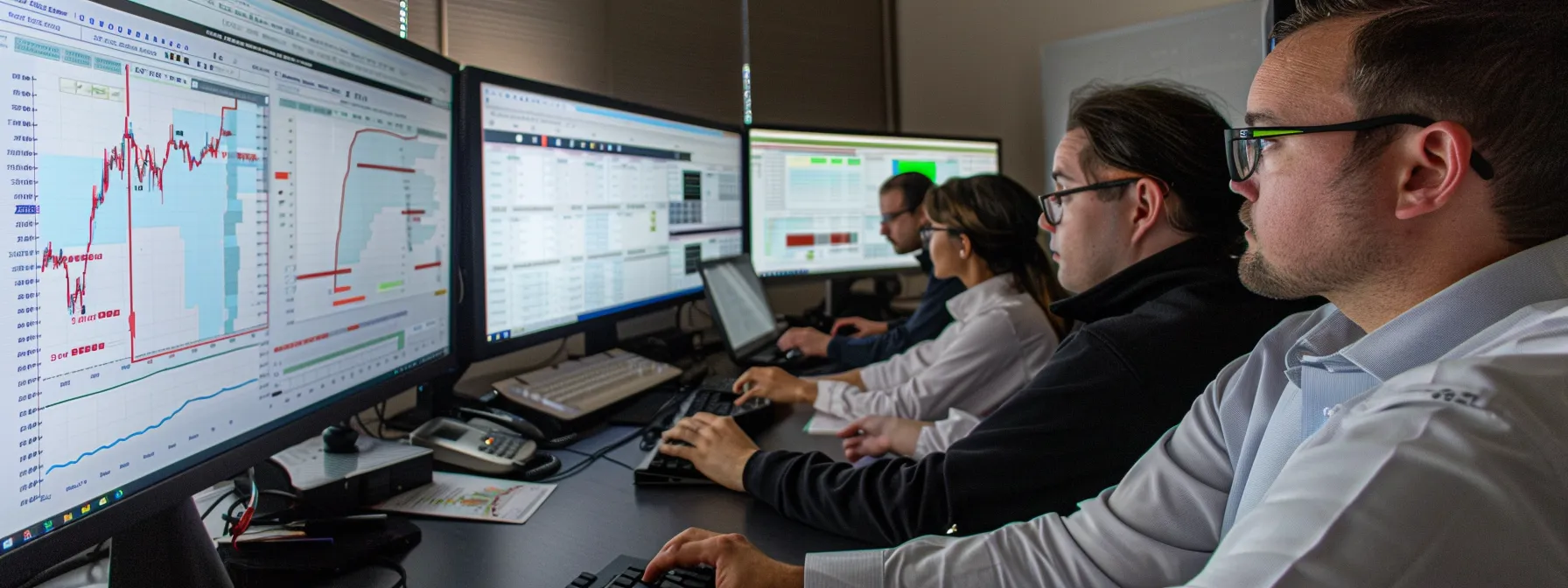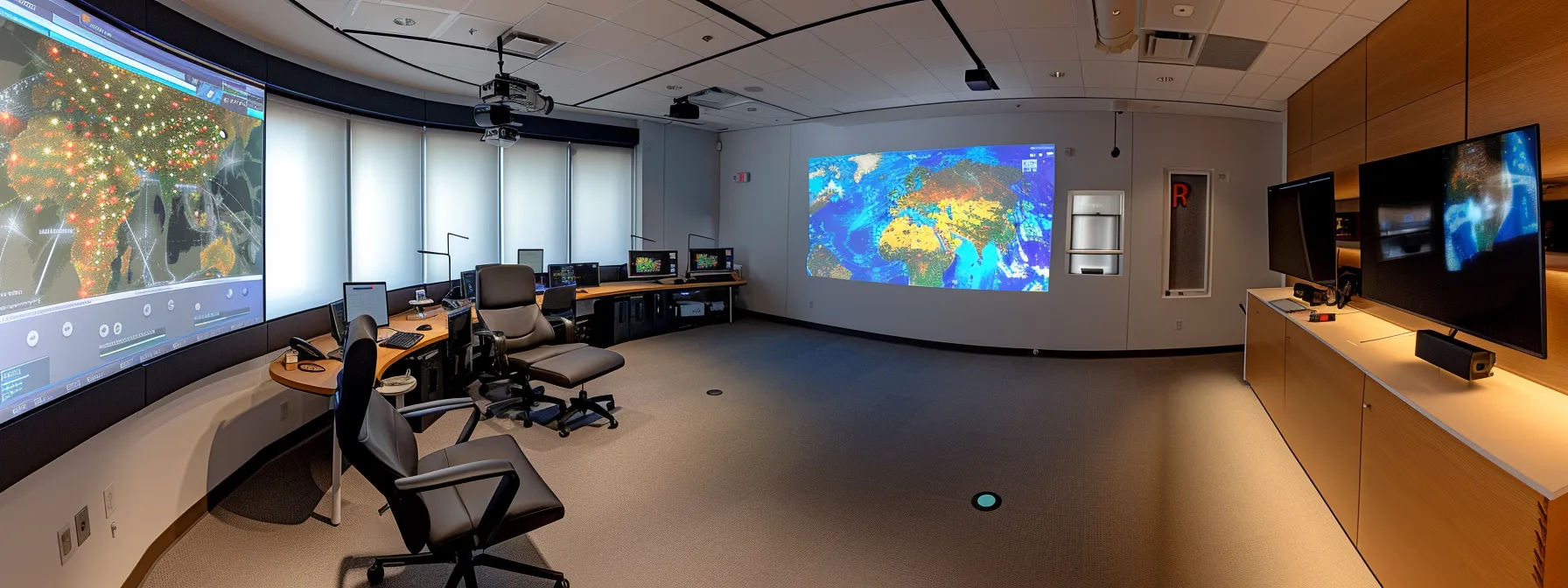Understanding the complexities of uncertainty can be a significant challenge for businesses today. This comprehensive guide to quantitative risk analysis methods will delve into essential approaches, including simulation and measurement techniques, to equip you with practical tools for effective decision-making. By exploring key methods like brainstorming for risk identification, you will learn how to systematically assess and manage risks. This content aims to alleviate your concerns by providing actionable insights, allowing you to make informed business choices while confidently navigating potential threats.
Introduction to Quantitative Risk Analysis

Quantitative Risk Analysis (QRA) involves defining risks through rigorous probability and statistics to assess potential failure impacts on projects and organizations. I’ll explore how quantitative methods, like decision trees and Expected Monetary Value (EMV), play a crucial role in risk management. Also, I will highlight the data requirements needed for effective analysis and discuss common challenges encountered during quantitative risk assessments.
Defining Quantitative Risk Analysis and Its Importance
Quantitative Risk Analysis (QRA) is a systematic approach to assess risks using mathematical methods and statistical techniques. By focusing on the prediction of potential threats, QRA enables businesses to understand the likelihood and impact of various factors affecting their operations. This data-driven methodology empowers organizations to make informed decisions, especially when defining mitigation strategies that can effectively address identified risks.
One critical aspect of QRA is its ability to incorporate environmental factors into the risk assessment process. By analyzing the density and distribution of these factors, I can gain deeper insights into how external influences may alter risk profiles. This is particularly important in industries where environmental conditions play a significant role in project success, allowing businesses to anticipate challenges and adjust their strategies accordingly.
The function of quantitative methods in risk assessment becomes evident through tools like decision trees and Expected Monetary Value (EMV). These tools facilitate a structured analysis that enables businesses to weigh options and forecast possible outcomes based on empirical data. By employing QRA, I find that organizations are not only able to enhance their resilience to risks but also unlock substantial value by optimizing their resource allocation and strategic planning efforts.
The Role of Quantitative Methods in Risk Management
Quantitative methods, such as sensitivity analysis and fault tree analysis, play a pivotal role in risk management by providing structured frameworks for understanding potential hazards. I utilize these methods to systematically evaluate how different variables interact within a given system. For example, by applying sensitivity analysis, I can determine which factors most significantly impact project outcomes, allowing for better resource allocation and risk mitigation strategies.
Furthermore, hazard analysis is integral to my approach in recognizing and prioritizing risks. By identifying potential hazards within processes or projects, I can develop informed strategies to minimize their impact. This proactive stance not only safeguards operations but also instills greater confidence among stakeholders regarding the organization’s commitment to risk management.
Through ongoing research and application of quantitative methods, I continually enhance my understanding of the risk landscape. By integrating these approaches into the risk management process, I can effectively communicate findings and strategies to relevant parties. This collaboration ensures that all team members are aligned with risk objectives, fostering a culture of awareness and preparedness:
| Quantitative Method | Purpose | Example Application |
|---|---|---|
| Sensitivity Analysis | Evaluate impact of variable changes | Assessing project cost variations |
| Fault Tree Analysis | Identify root causes of failure | Analyzing system failures in manufacturing |
| Hazard Analysis | Prioritize potential project hazards | Safety assessment in healthcare projects |
Data Requirements for Effective Analysis
To conduct effective Quantitative Risk Analysis (QRA), I start by gathering accurate and relevant data that informs the assessment of risk factors. This data must include potential scenarios that involve different probability distributions, allowing me to evaluate how various outcomes may influence project results. Accurate data collection is crucial as it forms the foundation for reliable analysis and supports precise risk mitigation strategies.
Using methods like the Monte Carlo Method, I can simulate a multitude of possible outcomes based on the input data. This statistical technique requires a comprehensive understanding of key variables and their interactions, which is enhanced by maintaining a high level of confidence in the data quality. By analyzing these simulations, I can prioritize risks and allocate resources effectively, tailoring strategies that align with the organization’s specific risk tolerance and preference.
Additionally, I pay close attention to ongoing data requirements throughout the analysis process. As projects evolve, the nature and impact of risk factors can change, necessitating regular updates and adjustments in the data used for risk assessments. By fostering a culture of continuous data evaluation, I can ensure that my risk management strategies remain relevant and effective, ultimately leading to enhanced organizational resilience in the face of uncertainty.
Overcoming Common Challenges in Quantitative Risk Assessment
One of the significant challenges in Quantitative Risk Assessment (QRA) is ensuring the accuracy of data used in simulations and scenario planning. I find that discrepancies in data can lead to miscalculations in expected value and risk assessments. To counter this, I implement rigorous data validation processes and continuous monitoring of data quality to ensure reliable outcomes.
Another common issue is the complexity of causality within risk factors. Many times, risks do not operate in isolation; rather, they are interrelated. I utilize methods such as sampling and sensitivity analysis to understand these relationships better. This helps me quantify how changes in one variable may influence multiple outcomes, thus enhancing the robustness of my risk assessments.
Lastly, a lack of engagement from stakeholders can hinder effective risk management. When team members aren’t actively involved, it becomes challenging to gather insights that enhance the assessment process. I make it a point to involve relevant parties early in the scenario planning stages, ensuring their perspectives help shape the risk management strategies I develop. Such collaboration fosters a collective understanding of the risks at hand and improves buy-in for necessary actions:
- Implement rigorous data validation processes.
- Use sampling and sensitivity analysis to assess causality.
- Engage stakeholders early in scenario planning.
Key Methods Used in Quantitative Risk Analysis

In this section, I will discuss essential methods in Quantitative Risk Analysis, including applying Monte Carlo Simulation for effective risk evaluation, utilizing Decision Tree Analysis for strategic decision making, and conducting Sensitivity Analysis to identify critical variables. Additionally, I’ll cover how to calculate Expected Monetary Value (EMV) for precise risk quantification and implement the Program Evaluation and Review Technique (PERT) in project planning.
Each method offers valuable tools that enhance our knowledge of risk, facilitates effective documentation, and supports analytics through integrated approaches like Failure Mode and Effects Analysis (FMEA) and risk matrices. Together, these techniques contribute to informed decision-making and robust risk management strategies.
Applying Monte Carlo Simulation in Risk Evaluation
Monte Carlo Simulation is a powerful strategy I frequently employ in risk evaluation to quantify uncertainty in asset values and project outcomes. By utilizing this method, I can simulate numerous scenarios that incorporate various risk factors, allowing me to understand how these uncertainties influence potential results. This approach provides a comprehensive view of the range of possible outcomes and helps inform risk management policies.
One of the key benefits of Monte Carlo Simulation is its ability to provide a confidence interval for potential outcomes, enhancing my decision-making process. By analyzing the distribution of values generated through simulations, I can identify the probability of outcomes falling within specific ranges. This insight is critical when evaluating the financial implications of risks, enabling me to devise mitigation strategies that align with the organization’s risk tolerance.
In practical terms, I’ve found that Monte Carlo Simulation helps not only in assessing risks but also in optimizing resource allocation. For instance, when deciding on capital investment strategies, I consider varying market conditions and project risks to determine the most favorable allocation of assets. The rich data generated from the simulation empowers me to advocate for informed decisions that enhance organizational resilience in the face of uncertainty.
Utilizing Decision Tree Analysis for Decision Making
In my experience, utilizing Decision Tree Analysis offers a structured visual representation of potential outcomes, allowing for informed decision-making in the face of market risk. By mapping out different paths based on various choices and their probable impacts, I gain insights into how decisions may affect business objectives. This clarity is essential, especially when considering how external factors, like shifts in market interest, could alter risk assessments.
One of the key advantages of Decision Tree Analysis is how it addresses stakeholder perception and behavior in decision-making. By clearly illustrating the potential consequences of alternative strategies, I can engage team members and stakeholders more effectively. Their input can significantly shape responses to identified risks, ensuring that the strategies developed are not only grounded in analytical rigor but also resonate with those impacted by the decisions.
Moreover, Decision Tree Analysis facilitates thorough audits of decision-making processes by documenting the rationale behind each choice. This breakdown not only aids in reassessing decisions in the future but also reinforces accountability within the organization. When I apply this method, I ensure it aligns with our overall risk management strategy, benefiting both operational efficiency and regulatory compliance.
Conducting Sensitivity Analysis to Identify Critical Variables
Conducting Sensitivity Analysis is crucial for identifying critical variables that influence project outcomes in risk assessment. By systematically adjusting specific parameters, I assess the impact of these changes on overall exposure to risk. This hands-on approach allows me to determine which elements have the most significant effect on safety and project performance, giving me insight into where to focus mitigation efforts.
During my assessments, I pay close attention to data collection, ensuring that I gather accurate metrics related to potential risk factors. For instance, if I notice that even minor variations in a key parameter substantially alter the likelihood of failure, I can prioritize this factor in my risk management strategy. This pinpoints areas where I can implement more robust safety protocols or allocate resources more effectively.
By employing this methodology, I create visual representations of the assessment process, which serves to clarify the relationships between various parameters. This structured analysis enhances communication within my team, as everyone can see the potential implications of different risk factors clearly. Ultimately, sensitivity analysis not only strengthens my risk assessment efforts but also fosters a proactive approach to managing exposure and enhancing organizational resilience:
| Parameter | Impact on Exposure | Possible Actions |
|---|---|---|
| Cost Overruns | High | Increase budget monitoring |
| Supply Chain Disruptions | Medium | Diversify suppliers |
| Regulatory Changes | Low | Regular compliance reviews |
Calculating Expected Monetary Value (EMV) for Risk Quantification
Calculating Expected Monetary Value (EMV) is a vital method I frequently utilize to quantify risk in a straightforward manner. EMV allows me to assess the potential financial impact of risks by weighing the probabilities of adverse effects against their monetary outcomes. This data analysis technique simplifies the complexity associated with operational risk, enabling me to prioritize which risks require immediate attention and resources.
To determine EMV, I multiply the probability of each possible outcome by its respective payoff and then sum these values for all outcomes. This approach not only provides a clear evaluation of potential risks but also helps me make informed decisions based on quantitative data. For instance, in a project where I identified a risk of equipment failure, I calculated the EMV to determine the most cost-effective risk mitigation strategy, ensuring that resources are allocated efficiently.
Moreover, applying EMV in my risk assessments enhances stakeholder transparency. By presenting a solid financial justification for risk management strategies, I can effectively communicate the rationale behind my recommendations. This element of clarity helps in addressing concerns related to operational risk and fosters a collaborative environment where all team members understand the impact of their decisions on overall project success.
Implementing Program Evaluation and Review Technique (PERT) in Projects
Implementing the Program Evaluation and Review Technique (PERT) in projects provides a structured framework for effective project management. By utilizing the PERT formula, I can estimate the minimum time required to complete a project, taking into account uncertain activities. This methodology is particularly beneficial in situations where project timelines are challenging to predict, as it focuses on evidence-based analysis rather than assumptions.
In my experience, PERT is advantageous for identifying the critical path within a project, allowing me to allocate resources efficiently. By mapping out tasks and their dependencies, I can prioritize activities that directly impact project completion. This not only enhances productivity but also ensures that potential delays are managed proactively, aligning with the principles of quantitative research to optimize project outcomes.
Furthermore, PERT serves as an effective communication tool among team members and stakeholders. The visual representation of project timelines and tasks facilitates clear discussions about objectives and deadlines. By employing this technique, I can present concrete evidence that supports our planning efforts, fostering greater collaboration and buy-in from all parties involved in the project.
Step-by-Step Guide to Performing Quantitative Risk Analysis

To perform effective Quantitative Risk Analysis, I first identify and prioritize risks, ensuring I focus on the most critical threats to our system. Next, I gather and analyze relevant data to support my analysis. Selecting appropriate quantitative risk analysis methods is vital, followed by interpreting results for informed decision-making. Finally, I emphasize the need for continuous monitoring and updating of risk assessments over time, including an environmental impact assessment to ensure all factors are considered.
This structured approach not only enhances the reliability of my findings but also facilitates a more nuanced understanding of how qualitative risk analysis can complement quantitative techniques, enriching our overall risk management strategy.
Identifying and Prioritizing Risks
Identifying and prioritizing risks is a critical first step in Quantitative Risk Analysis. I begin by engaging with stakeholders to gather insights regarding potential vulnerabilities in infrastructure. This engagement ensures that I capture comprehensive perspectives, which helps in creating detailed risk diagrams that map out each risk based on its potential impact and frequency.
To effectively prioritize risks, I evaluate each identified risk based on its likelihood of occurrence and the severity of its impact on the organization. For instance, I consider a risk’s frequency and potential disruption to business operations to determine its rank on the risk assessment matrix. This systematic approach allows me to focus on risks that pose the greatest threat, ensuring that resources are allocated effectively towards mitigation efforts.
After organizing risks, I communicate the findings through clear visual aids, like risk diagrams, to facilitate discussions among team members. This not only enhances understanding among stakeholders but also promotes alignment on how to tackle the prioritized risks efficiently. By following this structured process, I ensure that risk identification and prioritization are thorough and actionable:
- Engage with stakeholders to gather insights.
- Create risk diagrams to visually represent each threat.
- Evaluate risks based on frequency and impact for prioritization.
- Communicate findings through clear visual aids.
Gathering and Analyzing Relevant Data
Gathering and analyzing relevant data is essential for effective Quantitative Risk Analysis (QRA). I start by conducting a systematic review of existing data sources, ensuring that they encompass demographic factors such as population density, which can significantly influence risk assessments. This methodical approach helps to build a solid foundation of data, reducing the potential for bias and enhancing the reliability of the findings.
To further enrich the analysis, I focus on obtaining high-quality data related to various risk factors specific to the organization or project at hand. For instance, understanding how population density affects operational risks in urban environments enables me to anticipate challenges more effectively. This targeted data collection allows me to create a nuanced risk profile that guides decision-making in the risk management process.
Finally, as I analyze the gathered data, I employ statistical techniques to identify trends and correlations among risk factors. This analysis not only supports my overall assessment of quantitative risk but also enhances my ability to pinpoint critical areas that require attention. By addressing data quality and relevance, I improve the accuracy of risk predictions and ensure that my risk management strategies are well-informed and effective.
Selecting Appropriate Quantitative Techniques
When selecting appropriate quantitative techniques for project risk management, I first assess the specific needs and objectives of the project. Understanding the complexity of the project and the types of risks involved allows me to choose the most effective methods, such as Monte Carlo simulations for evaluating variability in project outcomes or decision tree analysis for mapping potential decision pathways. By tailoring these techniques to the project context, I ensure a focused approach that addresses potential risks effectively.
I often rely on sensitivity analysis to identify which variables most substantially impact project performance. This method helps me determine where to concentrate my mitigation efforts, ensuring that resources are allocated efficiently to address critical areas. Connecting the right techniques to the relevant risks not only enhances project risk assessments but also contributes to the overall success of the initiatives I manage.
Furthermore, integrating various quantitative methods allows for a comprehensive understanding of risk exposure across projects. I combine techniques like fault tree analysis with traditional quantitative Risk Assessment Services, equipping stakeholders with a detailed overview of potential failures and their impacts. This synthesized approach fosters better collaboration among team members and supports informed decision-making, ultimately leading to enhanced organizational resilience:
- Assess project needs to determine suitable techniques.
- Utilize sensitivity analysis to prioritize critical variables.
- Integrate multiple quantitative methods for a comprehensive risk view.
Interpreting Results for Informed Decision-Making
Interpreting results in Quantitative Risk Analysis is crucial for making well-informed decisions. I emphasize the importance of translating numerical data into actionable insights that align with organizational goals. By effectively communicating the implications of the analysis, I ensure stakeholders grasp not just the statistics but also their impact on strategic planning and risk management.
In my practice, I focus on synthesizing the quantitative data from simulations and analyses to highlight key risk factors and potential outcomes. For example, if a Monte Carlo Simulation reveals a high probability of cost overruns, I present this information clearly, illustrating how such risks could affect overall project success. This approach helps guide resource allocation toward mitigation efforts that address the most pressing threats, ultimately supporting better decision-making.
Furthermore, engaging stakeholders in the interpretation process enhances our collective understanding of the risks at play. I often facilitate discussions to explore the implications of risk analysis results, promoting collaboration in crafting risk management strategies. This not only fosters alignment among team members but also empowers stakeholders to take ownership of the decisions, which is essential for cultivating a culture of risk awareness within the organization.
Monitoring and Updating Risk Assessments Over Time
Monitoring and updating risk assessments over time are vital components of a robust Quantitative Risk Analysis strategy. As projects evolve and new variables emerge, I find that periodic reviews of risk assessments ensure that I stay informed about changing risk landscapes. This adaptability is essential for maintaining alignment between risk management strategies and the organization’s operational objectives.
One effective approach I employ is setting regular intervals for revisiting risk assessments, which allows me to incorporate fresh data and insights. For instance, after completing a major project phase, I analyze any shifts in risk profiles by evaluating how completed tasks may influence remaining project risks. By maintaining an updated understanding of our risk exposure, I can adjust mitigation strategies accordingly, ultimately improving our organization’s resilience.
To facilitate this ongoing process, I utilize a structured framework for documentation and monitoring. This includes maintaining a dynamic risk register that captures key information related to all identified risks, their statuses, and any changes made to mitigation strategies. Below is a summary of how I approach the monitoring and updating of risk assessments:
| Step | Description |
|---|---|
| Regular Reviews | Conduct periodic assessments to identify changes in risk exposure. |
| Data Integration | Incorporate new data and insights from completed phases. |
| Dynamic Risk Register | Maintain an updated record of risks and their mitigation statuses. |
Applications of Quantitative Risk Analysis in Various Industries

In various industries, Quantitative Risk Analysis (QRA) plays a vital role in informing decisions and enhancing outcomes. I will discuss how QRA is applied in finance and investment for managing market risks, in construction and engineering to enhance project success, and in healthcare for patient safety assessments. Additionally, I’ll cover the significance of managing risks in information technology and cybersecurity as well as conducting environmental risk analysis to promote sustainable practices.
Risk Management in Finance and Investment
In the finance and investment sectors, I find that Quantitative Risk Analysis (QRA) is essential for managing market risks effectively. By employing statistical models and probability theories, I can assess potential losses in various scenarios, enabling me to make informed investment decisions. This rigorous analysis allows me to navigate the complexities of market fluctuations and identify opportunities for optimizing returns while minimizing risk exposure.
One of the practical applications of QRA in finance is the use of Monte Carlo simulations to forecast investment outcomes. For instance, when evaluating a portfolio’s performance, I simulate numerous potential market conditions to understand the implications of different variables. This technique not only helps in predicting returns but also provides insights into the volatility of the investments, allowing me to adjust strategy based on empirical data.
Additionally, calculating the Expected Monetary Value (EMV) of various investment options is an integral part of my risk management approach. By weighing the probabilities of different financial outcomes against their monetary impacts, I can prioritize investments that align with my risk tolerance. This method equips me with a clear pathway for resource allocation, ensuring that every investment decision is backed by a thorough quantitative analysis aimed at fostering financial resilience.
Enhancing Project Success in Construction and Engineering
In the construction and engineering sectors, I utilize Quantitative Risk Analysis (QRA) to significantly enhance project success rates. By employing tools like Monte Carlo simulations, I can model various risk scenarios, allowing me to anticipate potential issues before they arise. This proactive approach not only minimizes unexpected setbacks but also helps in effective resource allocation, ensuring that projects stay on track and within budget.
One practical application of QRA is in project scheduling. I analyze the potential delays caused by factors such as supply chain disruptions or safety incidents. With this analytical perspective, I can prioritize critical tasks and streamline project timelines, ultimately improving overall efficiency and ensuring timely completion, which is vital in a competitive marketplace.
Furthermore, effective risk communication is crucial in construction and engineering projects. By translating complex quantitative data into clear insights, I engage stakeholders throughout the project lifecycle. This collaboration fosters a shared understanding of risks and the strategies in place to mitigate them, enhancing confidence among team members and clients alike, which is essential for successful project delivery.
Healthcare Risk Assessments for Patient Safety
In healthcare, Quantitative Risk Analysis (QRA) is vital for enhancing patient safety through systematic risk assessments. By identifying and analyzing potential risks, such as medication errors or equipment failures, I can implement targeted strategies that significantly minimize adverse events. For instance, using data-driven models allows me to evaluate the likelihood of incidents occurring, prioritizing my focus on high-risk areas that directly affect patient outcomes.
One practical application of QRA in healthcare involves the use of fault tree analysis to determine the root causes of risks associated with clinical procedures. By breaking down complex processes, I can pinpoint failure points and increase the reliability of interventions designed to protect patients. This structured approach not only enhances safety protocols but also fosters a culture of continuous improvement within healthcare facilities.
Furthermore, I combine QRA techniques with ongoing training and education to enhance staff awareness of potential risks. Regular risk assessments ensure that my team is informed about changes in procedures or emerging threats, leading to improved patient safety practices. By incorporating quantitative methods into our routine assessments, we create a comprehensive framework that not only protects patients but also builds trust in the care we provide:
| Risk Factor | Analysis Method | Mitigation Strategy |
|---|---|---|
| Medication Errors | Fault Tree Analysis | Enhanced prescription systems |
| Equipment Failures | Monte Carlo Simulation | Routine maintenance schedules |
| Clinical Procedure Risks | Root Cause Analysis | Standard operating procedures |
Managing Risks in Information Technology and Cybersecurity
In the realm of Information Technology and cybersecurity, I find that Quantitative Risk Analysis (QRA) is essential for assessing and mitigating digital threats. By employing statistical methodologies and tools, I evaluate potential risks such as data breaches and system failures, allowing me to prioritize cybersecurity measures effectively. For example, I utilize Monte Carlo simulations to forecast the likelihood of different cybersecurity incidents based on historical data, providing invaluable insights into which threats require immediate attention.
Another crucial aspect of managing risks in IT is identifying vulnerabilities within systems and networks. I often conduct thorough assessments using techniques such as fault tree analysis to pinpoint the sources of potential failures. This allows me to develop targeted strategies that not only address immediate risks but also enhance the overall resilience of IT infrastructures.
It’s vital to create a culture of risk awareness within the organization. By keeping stakeholders informed about the quantitative findings and risk management strategies, I foster collaboration among team members when addressing cybersecurity challenges. Effective communication includes providing regular updates and recommendations for best practices, which ultimately lead to more robust defenses against evolving cyber threats:
- Evaluate risks such as data breaches and system failures.
- Conduct vulnerability assessments using fault tree analysis.
- Foster a culture of risk awareness through stakeholder communication.
Environmental Risk Analysis for Sustainable Practices
In my experience, Environmental Risk Analysis plays a crucial role in promoting sustainable practices across various industries. By systematically evaluating the potential impacts of operational decisions on the environment, I can identify and mitigate risks that threaten not only compliance but also the integrity of natural resources. This analysis enables organizations to develop strategies that align with sustainability goals while maintaining operational efficiency.
Through quantitative methods, such as Monte Carlo simulations, I can predict the likelihood of environmental incidents and their consequences. For example, in assessing the risk of chemical spills in manufacturing processes, I utilize data-driven simulations to estimate potential environmental damage and associated costs. This allows me to propose effective mitigation measures, such as improved containment systems or employee training programs, ensuring compliance and protection of the environment.
Additionally, integrating Environmental Risk Analysis into project planning helps achieve long-term sustainability objectives. By conducting thorough assessments of environmental factors, I can provide insights that guide decision-making, reducing the likelihood of negative outcomes. This proactive approach not only enhances environmental stewardship but also fosters a positive reputation among stakeholders, ultimately contributing to a company’s success in achieving its sustainable development targets.
Comparing Quantitative and Qualitative Risk Analysis

Understanding the key differences between quantitative and qualitative risk analysis methods is essential for effective risk management. I’ll explore the advantages and limitations of quantitative methods, discuss scenarios where choosing quantitative analysis is beneficial, and demonstrate how integrating both approaches can enhance comprehensive risk management practices. This discussion will provide practical insights to guide informed decision-making.
Key Differences Between Quantitative and Qualitative Approaches
When comparing quantitative and qualitative risk analysis, the primary distinction lies in how each approach evaluates risks. Quantitative risk analysis employs numerical data and statistical methods to assess risks, providing measurable results that facilitate precise decision-making. In contrast, qualitative risk analysis focuses on the subjective assessment of risks, relying heavily on expert judgment and experience without the same level of numerical backing, making it less suitable for high-stakes environments.
Another key difference relates to the depth of insight each method provides. In my experience, quantitative analysis allows for a detailed exploration of risk scenarios by utilizing models like Monte Carlo simulations, which can simulate a range of outcomes based on varying inputs. This helps me predict not only the likelihood of certain risks occurring but also their potential financial impacts, creating a robust framework for resource allocation and strategic planning.
Ultimately, the choice between quantitative and qualitative approaches depends on the specific context and objectives of the risk assessment. I often find that qualitative methods are advantageous during initial stages of risk identification, while quantitative methods come into play for in-depth analysis and mitigation planning. Combining both approaches allows me to create a comprehensive risk management strategy that captures both the broad context of risks and the detailed numerical insights needed for effective decision-making.
Advantages and Limitations of Quantitative Methods
Quantitative methods in risk analysis provide a structured approach that allows for measurable assessments of risks. By applying statistical models and data-driven techniques, I can deliver objective results that facilitate informed decision-making. For instance, tools like Monte Carlo simulations help me predict the potential financial impact of various risks, enabling businesses to allocate resources efficiently and effectively.
Despite their strengths, quantitative methods have limitations that I must navigate carefully. One of the challenges I encounter is the reliance on high-quality data; inaccurate or insufficient data can lead to flawed analyses and misguided conclusions. Additionally, quantitative methods often do not capture the nuances of human behavior and organizational culture, which are critical components in understanding risk dynamics.
Integrating qualitative insights with quantitative analysis can enhance the overall understanding of risks. By combining both methodologies, I can address the strengths and weaknesses of each approach, ensuring a comprehensive view of risk exposure. This synergy allows me to not only rely on numerical data but also incorporate expert judgment and subjective assessments, leading to a more robust risk management strategy:
- Quantitative methods offer measurable and objective analyses.
- Dependence on high-quality data poses challenges for accuracy.
- Combining qualitative insights strengthens risk assessments.
Scenarios for Choosing Quantitative Over Qualitative Analysis
In complex projects where financial implications are significant, I often select quantitative analysis due to its ability to provide clear numerical evaluations of risks. For instance, when assessing investment opportunities, using methods like Monte Carlo simulations enables me to simulate various market conditions and understand potential returns and losses. This data-driven approach not only aids in optimizing investment strategies but also helps stakeholders visualize the financial impacts of different risk scenarios.
When I encounter projects with multiple variables and interdependencies, I find that quantitative methods excel in illustrating the relationships among those factors. Quantitative techniques, such as sensitivity analysis, allow me to determine how adjustments in one area can affect overall project outcomes. This capability proves invaluable, particularly in industries like construction, where tightly interconnected tasks require precise management to prevent cost overruns and delays.
Lastly, I prioritize quantitative analysis in situations where compliance and regulatory requirements demand substantiated decision-making. For example, in sectors like healthcare or finance, adhering to legal standards is critical, and I leverage quantitative data to support risk assessments. By presenting solid numerical evidence, I can justify risk management strategies to regulators and internal stakeholders, enhancing trust in our decision-making processes and ensuring alignment with organizational goals.
Integrating Both Methods for Comprehensive Risk Management
Integrating both quantitative and qualitative risk analysis methods enhances the overall effectiveness of risk management strategies. I have found that combining the numerical precision of quantitative methods, such as Monte Carlo simulations, with the contextual insights provided by qualitative assessments creates a more nuanced understanding of potential risks. This hybrid approach allows me to address the complex landscape of risk factors that businesses typically face, ensuring that my strategies are both data-driven and contextually relevant.
From my experience, using qualitative methods during the early stages of risk identification helps uncover hidden threats that may not be immediately apparent through quantitative analysis alone. For instance, conducting interviews with stakeholders provides valuable insights into potential vulnerabilities within processes that numbers may overlook. This foundational understanding lays the groundwork for implementing quantitative methods to evaluate the likelihood and impact of identified risks, creating a comprehensive risk profile.
Ultimately, the integration of both methods promotes collaboration among team members and stakeholders, fostering a shared understanding of risks and their potential impacts. When I present analyzed data alongside qualitative insights, it encourages open discussions about mitigation strategies and resource allocation. By merging perspectives from both quantitative and qualitative frameworks, I contribute to a more resilient organization capable of navigating uncertainties effectively:
| Method | Strengths | Applications |
|---|---|---|
| Quantitative Analysis | Provides measurable data and statistical insights. | Risk forecasting and financial assessments. |
| Qualitative Analysis | Offers contextual understanding and stakeholder insights. | Risk identification and scenario planning. |
| Integrated Approach | Combines numerical data with human insight. | Comprehensive risk management strategies. |
Best Practices for Effective Quantitative Risk Analysis

Best Practices for Effective Quantitative Risk Analysis
To achieve effective Quantitative Risk Analysis, I focus on several best practices. Ensuring data accuracy and reliability is fundamental for robust assessments. Leveraging advanced software tools enhances analyses while building my expertise in quantitative risk techniques strengthens my analytical abilities. Clear communication of findings to stakeholders guarantees informed decision-making, and I emphasize the importance of continuously improving the risk analysis process to adapt to changing circumstances.
Ensuring Data Accuracy and Reliability
To ensure data accuracy and reliability in Quantitative Risk Analysis (QRA), I prioritize rigorous data validation processes at every stage of analysis. I begin by assessing the sources of my data, ensuring they are credible and representative of the factors I need to evaluate. For instance, when gathering historical data for risk assessments, I verify its consistency and relevance by cross-referencing with multiple databases, which substantially reduces the risk of error in my analyses.
Moreover, I implement regular monitoring of data quality to adapt to changing conditions and emerging information. By establishing a feedback loop for data collection, I can promptly identify discrepancies and anomalies that may affect my risk evaluations. This proactive approach enables me to maintain a high level of confidence in the data I use, ultimately contributing to the effectiveness of my risk management strategies.
Lastly, I find that engaging stakeholders in the data collection process enhances the overall accuracy and reliability of my analyses. By involving team members who have firsthand knowledge of operational risks, I can gather valuable insights that quantitative data alone might not reveal. This collaboration not only improves data quality but also fosters a shared commitment to effective risk management across the organization.
Leveraging Advanced Software Tools and Technologies
Leveraging advanced software tools and technologies is essential in enhancing the effectiveness of Quantitative Risk Analysis (QRA). Through the use of specialized software, I can automate the data collection process, conduct complex simulations, and analyze large datasets with greater accuracy. For instance, deploying tools like Monte Carlo simulation software enables me to evaluate potential outcomes across multiple scenarios quickly, ensuring that I thoroughly assess risk exposure without being overwhelmed by manual calculations.
Moreover, these software applications often include built-in analytics capabilities that allow for real-time monitoring and updates of risk assessments. I can frequently revisit and refine my analyses, adapting my strategies based on the most current data inputs. This agility not only improves the accuracy of my assessments but also aligns with the organization’s dynamic risk environment, keeping us ahead of potential threats and ensuring compliance with regulatory standards.
Additionally, using advanced technology fosters better collaboration among team members and stakeholders. Many of these tools come equipped with visualization features that make it easier to present complex data in a digestible format. By sharing clear visual reports and dashboards, I can engage stakeholders effectively, ensuring that they understand the implications of various risks and feel included in the data-driven decision-making process, which ultimately strengthens our risk management efforts.
Building Expertise in Quantitative Risk Techniques
Building expertise in quantitative risk techniques is essential for effective risk management. My journey began with a commitment to understanding the statistical foundations that underpin these methods. I found that mastering concepts such as probability distributions and regression analysis provided me with the tools necessary to evaluate risks accurately and contextualize potential impacts on projects.
As I developed my skills, I focused on practical applications of quantitative methods. I routinely applied Monte Carlo simulations to forecast various scenarios in project planning, which enhanced my ability to assess uncertainty and its implications. This hands-on approach not only solidified my understanding but also allowed me to communicate complex ideas clearly to stakeholders, bridging the gap between theoretical knowledge and actionable strategies.
Continuous learning has been a cornerstone of my expertise in quantitative risk techniques. I regularly engage in professional development opportunities, such as workshops and online courses, to stay updated on emerging tools and methodologies. By fostering a mindset of growth and exploration, I have been able to integrate innovative practices into my risk analysis processes, ultimately improving the reliability and effectiveness of my assessments.
Communicating Findings to Stakeholders Clearly
When communicating findings from Quantitative Risk Analysis, I prioritize clarity and simplicity to ensure stakeholders grasp essential insights without confusion. Utilizing visual aids, such as graphs and charts, helps illustrate complex data and makes the implications of the analysis more accessible. For example, I often incorporate visual representations of risk probabilities and potential impacts, enabling decision-makers to understand the urgency and relevance of identified risks quickly.
In my experience, tailoring the presentation of findings to the audience’s level of understanding proves crucial. I focus on providing context around the quantitative data, highlighting how it relates to organizational goals or specific projects. This approach helps stakeholders connect the dots between analysis and actionable strategies, fostering a greater appreciation for the importance of risk management and its alignment with overall business objectives.
Additionally, I emphasize the importance of interactive discussions when sharing findings. Encouraging questions and facilitating dialogue during presentations not only clarifies any uncertainties but also invites stakeholder input regarding risk perceptions and mitigation strategies. This collaboration not only ensures a comprehensive understanding of the quantitative risk analysis results, but also promotes a shared commitment to addressing risks effectively across the organization.
Continuously Improving the Risk Analysis Process
Continuously improving the risk analysis process is essential to keeping our methodologies relevant and effective. I regularly assess the tools and techniques I employ, identifying areas where enhancements can be made to ensure that they meet the evolving needs of the organization. By embracing new technologies and methodologies, I can refine my quantitative risk analysis techniques, providing more accurate insights that lead to better decision-making.
Another important aspect of improvement is soliciting feedback from stakeholders involved in the risk assessment process. Engaging team members allows me to capture diverse perspectives and identify any gaps in our approach. For example, after presenting analysis findings, I ask for their thoughts on the clarity and applicability of the information, which helps me adjust my communication and analysis strategies as needed.
Finally, fostering a culture of continuous learning within my team is a priority. I encourage team members to pursue ongoing training in risk management tools and techniques, which equips them to contribute more effectively to our risk analysis efforts. Regular workshops and knowledge sharing sessions not only boost our overall capabilities but also strengthen our collective understanding of quantitative risk analysis, driving continuous improvement across our processes.
Conclusion
Understanding Quantitative Risk Analysis methods is crucial for organizations aiming to enhance resilience and make informed decisions amidst uncertainty. These methods empower businesses to accurately assess risks using statistical techniques, enabling them to allocate resources effectively and prioritize mitigation strategies. By integrating approaches like Monte Carlo simulations and decision trees, organizations can uncover insights that drive proactive risk management. Ultimately, mastering these techniques enhances overall operational efficiency and elevates an organization’s ability to navigate complexities in today’s dynamic business environment.




